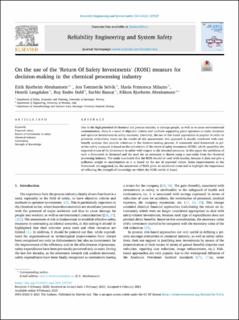| dc.contributor.author | Abrahamsen, Eirik Bjorheim | |
| dc.contributor.author | Selvik, Jon Tømmerås | |
| dc.contributor.author | Milazzo, Maria Francesca | |
| dc.contributor.author | Langdalen, Henrik | |
| dc.contributor.author | Dahl, Roy Endre Holsvik | |
| dc.contributor.author | Bansal, Surbhi | |
| dc.contributor.author | Abrahamsen, Håkon Bjorheim | |
| dc.date.accessioned | 2023-02-22T11:43:08Z | |
| dc.date.available | 2023-02-22T11:43:08Z | |
| dc.date.created | 2021-07-12T15:42:45Z | |
| dc.date.issued | 2021 | |
| dc.identifier.citation | Abrahamsen, E. B., Selvik, J. T., Milazzo, M. F., Langdalen, H., Dahl, R. E., Bansal, S., & Abrahamsen, H. B. (2021). On the use of the ‘Return Of Safety Investments’(ROSI) measure for decision-making in the chemical processing industry. Reliability Engineering & System Safety, 210, 107537. | en_US |
| dc.identifier.issn | 0951-8320 | |
| dc.identifier.uri | https://hdl.handle.net/11250/3053215 | |
| dc.description.abstract | Due to the high potential of chemical and process industry to damage people, as well as to cause environmental contamination, there is a need of objective criteria and methods supporting plant operators to make decisions and optimise investments in safety measures. Currently, the use of risk-based approaches is popular in order to prioritize criticalities, based on the results of risk assessments; this approach is usually combined with cost-benefit analyses that provide criterions in the decision-making process. A commonly used framework to prioritise safety measures is based on the calculation of the return of safety investments (ROSI), which quantifies the expected return of the investment in safety with respect to the invested resources. In this paper the usefulness of such a framework is discussed and the need for an extension is shown using a case-study from the chemical processing industry. The study concluded that the ROSI should be used with caution, because it does not give a sufficient weight to uncertainties as it is based on the use of expected values. Some improvements to the framework are suggested, i.e. the assessment of ROSI given an accidental event and to highlight the importance of reflecting the strength of knowledge on which the ROSI metric is based. | en_US |
| dc.language.iso | eng | en_US |
| dc.publisher | Elsevier | en_US |
| dc.rights | Navngivelse 4.0 Internasjonal | * |
| dc.rights.uri | http://creativecommons.org/licenses/by/4.0/deed.no | * |
| dc.title | On the use of the ‘Return Of Safety Investments’ (ROSI) measure for decision-making in the chemical processing industry | en_US |
| dc.type | Peer reviewed | en_US |
| dc.type | Journal article | en_US |
| dc.description.version | publishedVersion | en_US |
| dc.rights.holder | The authors | en_US |
| dc.subject.nsi | VDP::Teknologi: 500 | en_US |
| dc.subject.nsi | VDP::Samfunnsvitenskap: 200 | en_US |
| dc.source.pagenumber | 1-12 | en_US |
| dc.source.volume | 210 | en_US |
| dc.source.journal | Reliability Engineering & System Safety | en_US |
| dc.identifier.doi | 10.1016/j.ress.2021.107537 | |
| dc.identifier.cristin | 1921526 | |
| cristin.ispublished | true | |
| cristin.fulltext | original | |
| cristin.qualitycode | 2 | |

